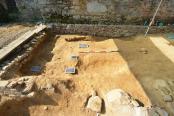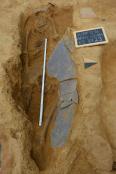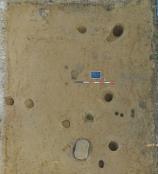CAMPAGNA 2016 |
1° SETTIMANA |
2° SETTIMANA |
3° SETTIMANA |
4° SETTIMANA |
5° SETTIMANA |
6° SETTIMANA |
08 LUGLIO 2016 
Resoconto della giornata di scavo
Area 2000
FOTOGRAMMETRIA 3D DELLO SCHELETRO MEDIEVALE USk 2730
Oggi è iniziata l’indagine del taglio US -2733 nella porzione centro orientale del Settore A; questo presenta una forma allungata rettangolare abbastanza regolare e si colloca parallelo alla struttura laterizia USM 2100 con andamento Ovest Est. All’interno il riempimento presenta numerose ossa in deposizione secondaria che sono state parzialmente messe in luce; ancora non è chiaro se si tratti di un ossario o di una riduzione posta al di sopra di un individuo in connessione anatomica.
Terminata la documentazione e la rimozione dello scheletro Usk 2730.
Friday the group finished up ongoing projects, opened a new site and began cleaning a large area for analysis. Vicki, Jaidee and Lydia finished removing 2730 and completed the necessary forms and soil sampling. Unfortunately, the remains were not associated with additional grave goods beyond the previously discovered rosary. Shelby, Morgan and Courtney began to excavate a fill on the east end of sector A and found scattered skeletal elements instead of an intact skeleton. Mark finished the grave he was working on in the northwest region of the west extension and moved to the northeast area of sector A to begin cleaning in order to take points and reveal more cuts.
Area 3000
Lungo il perimetrale meridionale USM 5003, ad Ovest, si è proceduto con la rimozione del riempimento US 3703 all’interno del taglio US – 3702, che sta mettendo in evidenza un individuo infantile, orientato W-E, che sembra intercettare i resti scheletrici dei due subadulti USK 3704 e USK 3708, anch’essi supini e con lo stesso orientamento. Nella porzione centro settentrionale la rimozione delle lastre di scisto US 3723 lungo la parete settentrionale della fossa sepolcrale US – 3706 ha permesso la messa in luce del lato sinistro del corpo dell’inumato USK 3709, in parte intercettato dalla fornace per la fusione e la gettata della campana di XVI secolo, e a questa precedente. US – 3706 sembra tagliare a sua volta la porzione occidentale di un’altra fossa sepolcrale, ancora più antica. Più ad Ovest, immediatamente a ridosso della facciata USM 3335, sono sati individuati i limiti di un taglio di forma allungata (US – 3720), orientato W-E, in cui è stato deposto l’inumato USK 3722, ancora in corso di scavo. Molto importante per la ricostruzione della storia della frequentazione sito sarà comprendere il rapporto fra la sepoltura in questione e la facciata dell’abbazia di XII secolo. Tale aspetto sarà meglio chiarito all’inizio della prossima settimana.
Group 1: We finished clearing out all the osteological fill for our primary burials. During the process the thoracic region for one of our primary skeletons was exposed (ribs and possibly vertebrae). We also exposed a foot which was at a slightly lower level than our other two skeletons. We left it, and anticipate a third potential burial beneath our first two.
Group 2: We continued to expose the two sets of skeletal material located addjacent to the bell oven. The first set of material is almost completely exposed, but the second is exposed from the pelvis to the begining of both tibia.
Group 3: I exposed an area of a right humerus and part a of a radius that was joined. The rest of the skeleton was missing. We took points and photographs and continued to excavate the area and remove the bones from the area.
Group 4: Student was advised by Supervisor to clean grave for photographs and coordinate points. Fill and Cut Context Sheets were filled by Student, noting that this grave was possibly the site of a young child. The floor of the grave had definite changes in color and may have another grave further below.
Group 5: Today we mapped in points for the skeleton and finished exposing the lower half. We started excavating the thorax and exposed up to the T12 vertebra, at which time we discovered the the stone wall cuts through the grave. We finished the day with some pictures and mapping.
Area 5000

Il Settore Settentrionale dell'Area 5000, caratterizzato da una cospicua sere di buche ed attività di frequentazione.
On this the tenth day of the field school, we started the day with a quick clean of Sector B, which revealed that there were 18 holes to excavate instead of the 13 we had previously observed. Pictures were taken of the holes and US numbers were assigned to each. GIS points were also taken of all of the holes. Excavation then began on nine of the holes. One hole produced structural elements including plaster. Another contained a brick with potential Roman links. Multiple holes contained limited amounts of pottery fragments. It was found that two holes that were previously considered separate were in fact connected together. This hole continues to expand. Various styles and sizes of pottery fragments were found in this large hole. Also, various faunal remains were discovered in this hole, along with a piece charred wood. The wood will be sent to Pisa for carbon isotope dating. The final hole, located where the original church wall once stood, produced what appeared to be part of a human skull. Excavation of the apparent skull will begin on the eleventh day of field school.
Area 6000
Today, we split our group into two, one group working on the Western Enlargement, while the other finished pickaxing Section B. In the Western Enlargement, we troweled in order to find cuts in the wall and exposed potential lithic burials. After pickaxing Section B, the second group clean troweled the area to reveal the new context. While doing so, numerous skeletal elements were uncovered. These appear to be burials oriented West to East.











